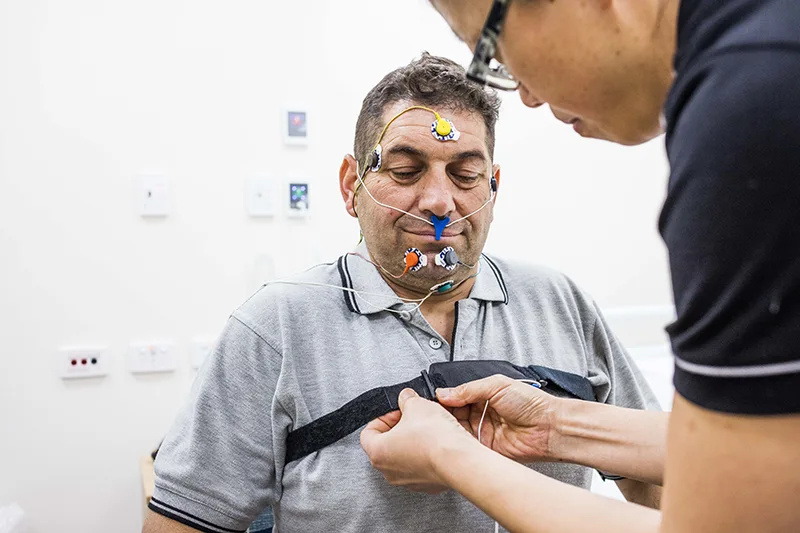Problems with sleep have been linked to cardiovascular disease, stroke, high blood pressure, mood disorders, and an increased risk of workplace and traffic accidents.
One in three Australians will have a sleep disorder at some stage in their life and more people are using smart devices to help track their sleep.
Dr Michelle Caldecott is a sleep and respiratory physician, and Director of the Internal Medicine Clinical Institute at Epworth HealthCare.
Dr Caldecott said there’s an increasing number of patients using smart technology, such as watches, to better understand their sleep.
“Their smart devices can detect snoring and sleep disturbance, but they do have limitations,” Dr Caldecott said.
“Smart devices use actigraphy to track movements thereby determining if the patient is awake or asleep, however they can’t always accurately determine the stage of sleep someone is in.”
If a smart device indicates disrupted sleep and the person experiences symptoms like daytime sleepiness, it's crucial to seek medical advice. However, Dr. Caldecott notes that many individuals often neglect to take action.
“Some people worry that they might need a Continuous Positive Airway Pressure (CPAP) machine to help with their breathing at night. However, before considering CPAP, it's essential to identify the underlying causes of their fatigue or disrupted sleep.”
“It is important for people to know there are causes of daytime sleepiness other than obstructive sleep apnoea (OSA) There are many non-respiratory sleep disorders, which can be effectively diagnosed and treated. “
In the past, sleep apnoea was mainly considered a problem of older, overweight men. Dr Caldecott said there are other factors such as family history, ethnicity, facial structure and menopausal state that influence likelihood of sleep disordered breathing.
Dr Caldecott said it is interesting to see the different ways patients present to sleep physicians.
”Men usually seek help after their partner notices issues with their sleep, such as snoring or other warning signs. In contrast, women often attend appointments alone, typically reporting symptoms like tiredness or fatigue. Additionally, women tend to describe their sleep issues differently and are more likely to report physical symptoms such as headaches or mood disorders.”
“Many women experiencing sleep disorders are also going through menopause and, unfortunately, they often accept poor sleep as an inevitable part of this stage of life due to historical perceptions. .”
Individuals suspected of having sleep apnoea can participate in a home sleep study. This involves being connected to portable diagnostic equipment in a sleep laboratory and then returning home to sleep in their own bed. Conversely, patients believed to have non-respiratory sleep disorders may need to undergo an in-hospital sleep study at Epworth Camberwell, Epworth Richmond or Epworth Geelong.
Epworth has a proud history of treating sleep disorders for almost 40 years. In fact, Australia's first sleep disorder study was conducted at Epworth Richmond in 1988. Two years later, the internationally recognised standard in assessing sleep disorders, known as the Epworth Sleepiness Scale, was developed. It is still the benchmark assessment used today.
“Four decades later, the Epworth Sleepiness Scale continues to be the most universally accepted tool to assess sleepiness,” Dr Caldecott said.
Epworth Camberwell opened the current Epworth Sleep Unit in May 2004. In the last 20 years, more than 40,000 sleep studies have been performed at Epworth and in patients’ homes.
At Epworth, a team of 70 sleep physicians is supported by 25 sleep scientists.
Darrel Wicks, Group Manager, Epworth Sleep Services said sleep disorders can have significant impacts.
“Problems with sleep have been linked to cardiovascular disease, stroke, high blood pressure, mood disorders and the increased risk of workplace and traffic accidents,” Mr Wicks said.
It’s the workplace and traffic accident risk that has brought about a new group of patients.
“For about six years it has been a VicRoads requirement that if you have a commercial licence and you have been diagnosed with a sleep disorder, you need to be regularly tested and reviewed,” Mr Wicks said.
“We conduct vigilance testing for truck, train, and tram drivers, as well as commercial pilots, by creating a sleep-inducing environment in a comfortable chair within a soundproof room. They are instructed to stay awake for 40 minutes across four sessions throughout the day. Passing this test allows them to continue their commercial roles."
For advice on how to get a better night’s sleep, check out our blog.




